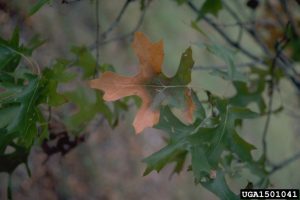Oak Wilt – Bretziella fagacearum
Pathogen: Bretziella fagacearum (previously Ceratocystis fagacearum)
Hosts: All oak species. Members of the red oak group (red oak, black oak, and pin oak) are more susceptible and can die very quickly. Members of the white oak group (white oak and bur oak) are less susceptible and show a slow decline.
Symptoms: Leaves on infected trees initially become dull green and appear wilted. Many leaves develop bronze/brown tissues from their tips and margins to the base and midrib. Hence, there is usually a distinct line between green and brown tissue. These symptoms can be confused with bacterial leaf scorch, anthracnose, Tubakia leaf spot, environmental scorch, iron chlorosis, drought, winter injury, among others.
Symptoms appear quickly throughout the crown on red oak. Many green leaves may defoliate from branches. Conversely, leaves may cling to the trees later into the fall than normal. Sprouts frequently develop from the bole (base) of the tree and larger branches. As incredible as it may seem, huge red oaks can be killed in less than 1-2 months. Symptoms in white oaks may be more variable. Usually, white oaks die much more slowly, or in some situations may seem to recover. White oaks may also harbor the pathogen as symptomless carriers.
Fungus mats called pressure pads often develop on red oaks but seldom on white. When they enlarge, these fungal mats actually push the bark away from the trunk. Red oaks may exhibit discolored annual rings whereas white oaks do not. A sweet fruity aroma may be detected from oak tissues from larger sections of the tree, but it may be difficult to detect this on small twigs or limbs. Heat from the summer temperatures may kill the fungus, making detection of the fungus difficult by laboratory methods, especially on small twigs.
Spread: Oak wilt is transmitted by bark beetles and sap-feeding beetles. These insects are attracted to the fungal mats which exhibit a fruity odor on infected trees. The insects carry fungal spores and mat material (mold) to healthy trees, effectively inoculating them. We have noticed that trees that are pruned during the early summer often contract oak wilt during the same season. Pruning cuts can attract the sap beetles. Oak wilt can also be transmitted short distances via root grafts between nearby or adjacent trees.
Management: Samples of trees suspected of having oak wilt should be submitted for testing. Early detection is paramount for saving other nearby trees. Monitor valuable oak stands for the presence of oak wilt. Once oak wilt has been detected, consider the following options:
- Trees which have died should be inspected for the presence of bark beetles even though trees have been cut down. Especially scrutinize logs the following spring when mat development is most likely. Trees with oak wilt should be destroyed. Do not leave infected logs in sites because the fungus can remain viable for several years.
- Destroy root grafts by trenching, this severs root grafts between infected trees and apparently healthy trees.
- Injections of apparently healthy trees with fungicides may help prevent infections or “cure” mildly infected trees, especially those in the white oak group.
- Never prune oak trees during the high-risk months of April – June.
- Be very careful of construction damage, because wounded or stressed trees attract the oak wilt fungus-laden insects.
For more information on oak wilt, please read "Worried about oak wilt?" by Dr. Monique Sakalidis, Michigan State University, Department of Forestry.




 Print
Print Email
Email




